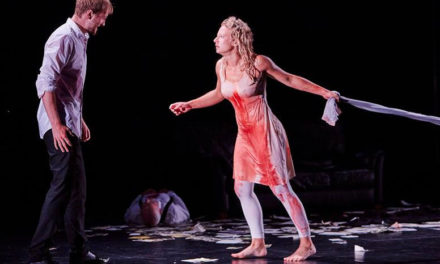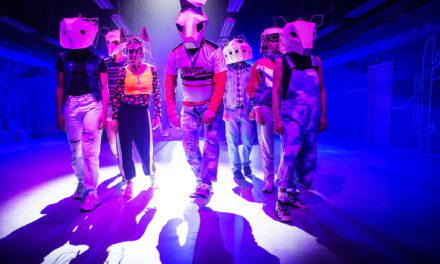One night in April, I found myself holding my cat up to my laptop, eagerly showing her off to a group of strangers on Zoom. I was, in fact, an audience member immersed in a production of Shakespeare’s The Tempest by Creation Theatre, based in Oxford, U.K.
Over the course of the show, produced entirely over Zoom, I was tasked with asking questions of the characters in a news conference, providing sound effects like bird squawks and stormy weather and holding up props (like my cat) when requested.
Given social-distancing protocols that prohibit physical gatherings, theatre-makers have responded creatively to the COVID-19 pandemic by turning to online, digital and lo-fi or “non-embodied” modes of performance that use radio and phone.
This change in how to perform theatre has required a reconsideration of longstanding ideas of what it means to be a theatre audience member: How has access to theatre changed? What etiquette is expected? How have ideas of privacy and intimacy shifted?
Rise of alternate forms of theatre
Most obviously, streamed versions of pre-recorded theatrical productions have enjoyed great popularity. #JaneEyre became a trending topic on Twitter in April 2020 after the National Theatre in London, U.K., aired a recording on YouTube, with more than 4,600 tweets in the seven days after it streamed.
Digital analytics by the company OneFurther about online viewing of One Man Two Guvnors by Richard Bean, based on the 18th-century Servant of Two Masters by Carlo Goldoni, count a staggering 2.6 million viewers over the course of one week. Such views are far beyond the seating capacity of a regular theatre building.
This increased access is especially important in light of growing awareness of inaccessibility in the theatre more broadly. Some progress has been made to better welcome audience members with certain disabilities, especially in the advent of relaxed performances, which seeks to “relax” or loosen audience conventions in order to create more accessible theatre. But systemic issues of racism, classism and ableism continue to exclude many potential spectators.
Streaming and diversifying audiences
Shakespeare scholar Erin Sullivan cites the U.K. Arts Council’s report “From Live-to-Digital” to point to the potential of streamed performance to increase access to the theatre: “Streaming does appear to attract younger, less wealthy and more ethnically diverse members of the population.”
What’s also notable about online performances is that, as an audience member, I can choose when, where and how to watch. Scholar Kirsty Sedgman, who studies theatre and performance audiences, has written extensively about audience etiquette and how such behavioural expectations are often exclusionary: you must be quiet, immobile and have a singular focus. If you don’t, you need to leave.
Within the privacy of my own home, however, such rules are removed. I can eat, drink, talk and be on my phone — or so one would think.
Actress Gillian Anderson asked audience members to stay off their phones while watching the National Theatre’s streamed version of A Streetcar Named Desire, which she starred in at the Young Vic in London. She thereby tried to enforce public theatre behaviours in private.
Live-tweeting at performances already OK
That live-tweeting alongside performances is already a well-established practice that means that expected audience behaviours must be renegotiated for online viewing.

Still from the live streamed drama ‘Blind Date’ by Spontaneous Theatre. (YouTube)
I, for instance, eagerly read the comments of my fellow audience members during a YouTube live stream of Blind Date, a show from Toronto-based Spontaneous Theatre centred on a virtual first date between Mimi (a French clown played by Rebecca Northan) and actor Wayne Brady.
The ways in which audience members can connect with each other in the absence of shared physical space means that virtual sites of conversation — like Twitter and the YouTube comments section — become vital.
Privacy unbound?
Finally, questions of privacy are also important. In The Tempest, I saw into several peoples’ homes and watched them leave and return with snacks or get interrupted by their children and pets. The boundaries between public and private lives were blurred and I had a deeper awareness of my fellow spectators.
In a cleverly customized theatrical experience from Toronto’s Outside the March Theatre, a “detective” attempted to solve my possibly paranormal printer problems over the course of six phone calls. In this interactive performance experience called The Ministry of Mundane Mysteries, I was also asked to reveal aspects of my personal life: where I worked, what my hobbies were, and so on.
As an audience member of such performances, I was asked to contribute and reveal more than I might be sitting in the quiet darkness of a traditional theatre. This is not to say that audiences haven’t been active participants in theatre throughout history, but the visibility of such participation is made more evident by the theatre’s move into private spaces.
Rethinking the future
A recent article in the New York Times suggests that the current explosion of digital theatre is merely a way of holding space before we can return to “real” theatre.
But this ignores the inventive responses of theatre artists who have shown that theatre is patently not tied to theatres: the presence of a public building is not a necessity for performance. Indeed, many artists were creating innovative online work long before the pandemic.
With theatres thinking about a return to physical spaces, it is worth considering how the “digital turn” will impact future spectator conventions and expectations. Renegotiated and re-imagined ideas of access, community, and interactivity, borne out of necessity, are an opportunity to rethink theatre. These should not be ignored when the return to public spaces happens: rather, they should inform the theatre’s future.
This article was originally posted at theconversation.com on July 21, 2020, and has been reposted with permission. To read the original article, click here
This post was written by the author in their personal capacity.The opinions expressed in this article are the author’s own and do not reflect the view of The Theatre Times, their staff or collaborators.
This post was written by Kelsey Jacobson.
The views expressed here belong to the author and do not necessarily reflect our views and opinions.


















